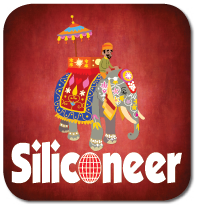EDITORIAL: Reviving Indian Artisans
|
The Siliconeer App
 Siliconeer is now available as a native app for iPhone and iPad on Apple’s App Store and on Google Play, the store for apps on Android phones. Siliconeer is now available as a native app for iPhone and iPad on Apple’s App Store and on Google Play, the store for apps on Android phones.
The app features different ways to read Siliconeer, get instant updates and also features interactive tools.
Readers can see the latest updates, read the issue in magazine format, view the deals by our advertisers, view photos and videos of latest community events, get Facebook and Twitter feeds and share photos and thoughts with other readers of Siliconeer through Reader’s Choice.
We encourage you to explore the app on your smartphone. The app is free and available for download now.
Click on the app image to download.
|
Since ancient times, artisans and craftsmen have been the basis of India’s rural economy, cultural diversity, art, religion, fashion and a large export, that flooded the markets of the Middle Eastern and Western worlds.
According to a recent study conducted by United Nations, in the last three decades the number of artisans dwindled to a third indicating a continuous downward slide of these invaluable micro-cultures.
Hence, when it comes to strategies and processes for revival and revitalization of these cultures and art forms, direct patronization and the bridging of gap between consumers and buyers, and rural market or artisans, proves significant and primary to the elimination of non-productive and parasitic class of middlemen or intermediaries.
Achieving this escalates the income of artisans by making their goods available to a larger and more-affluent worldwide audience, and from the customers’ perspective, it means more availability of exotic, previously inaccessible goods, at more affordable prices, writes Priyanka Bhardwaj.
Indian Prime Minister Dr. Manmohan Singh and U.S. President Barack Obama met at the White House, Sept. 27. Marking their third bilateral summit, the two leaders reflected proudly on the transformation of United States-India relations during the last decade, affirming that the partnership between the two democratic nations is stronger today than at any point in its 67-year history. Siliconeer presents a report.
Immigrant Indians have the highest rates of coronary heart disease among all ethnic groups living in the United States. This is in spite of the fact that 50% of them are lifelong vegetarians. Most of them are also non-smokers, weigh less and have no higher cholesterol than their western counterparts. Yogesh Verma discusses some of the underlying reasons for this paradox.
South Asians, and other minority groups lack awareness for the Bone Marrow Registry, and are reluctant to register. SAHI, South Asian Health Initiative, was founded by three college students, aiming to create that awareness and encourage people to register, potentially saving someone’s life, writes Yasaswi Vengalasetti.
Three Marwari deities, Khatu Naresh Shyam Baba, Jhunjhunu ki Ranisati Dadi and Salasar ke Balaji, were welcomed to Sunnyvale Hindu Temple with a lot of splendor and dedication. The enthusiasm was evident in the local Marwari community, who worships these deities and often does so by visiting Salasar, Khatu and Jhunjhunu in Rajasthan, India.
This is the first time that these deities have a temple outside Rajasthan. Siliconeer presents glimpses of this colorful celebration.
Siliconeer wishes all a very happy and prosperous Diwali!
|